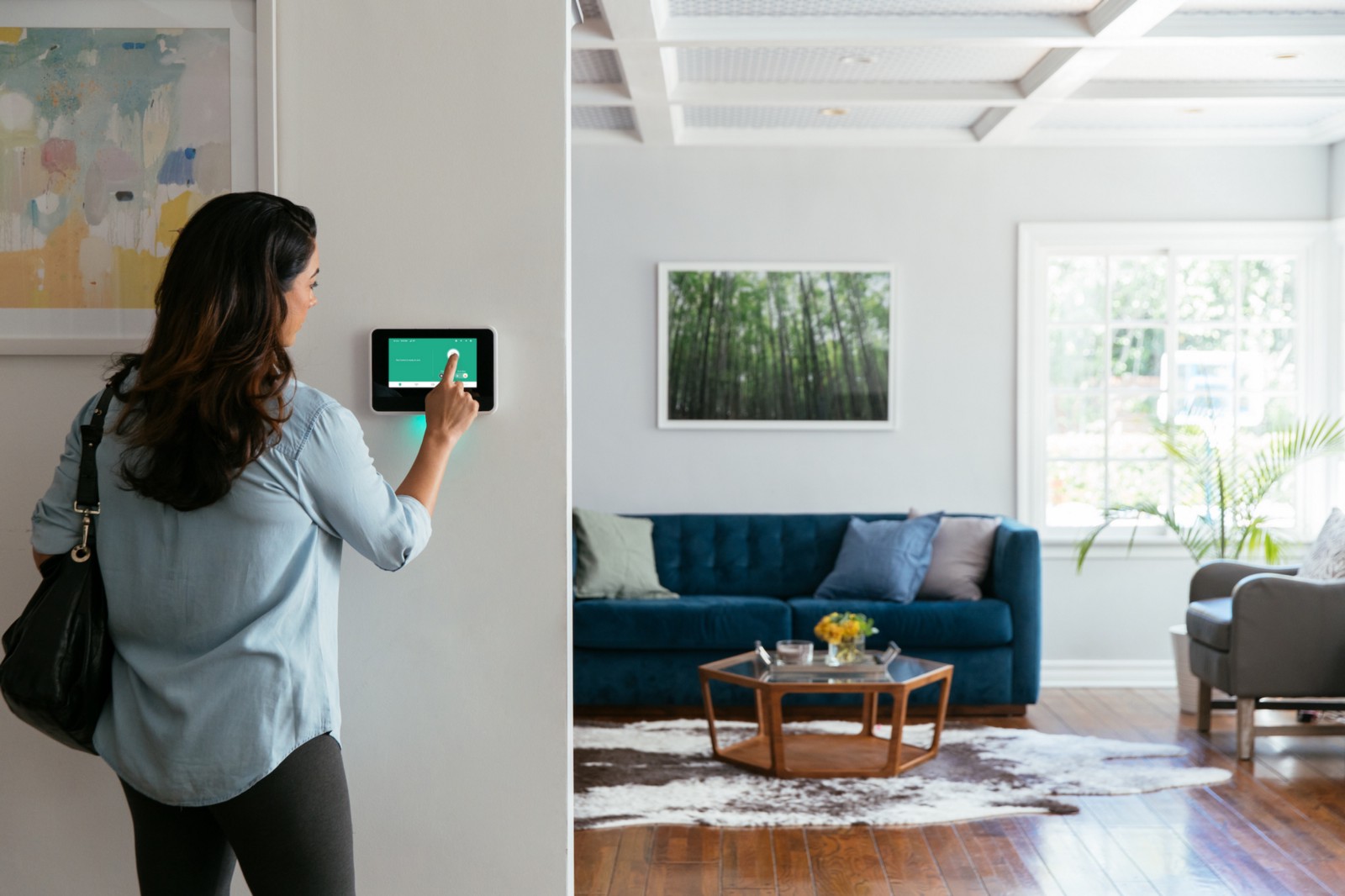Thanks to the rise in self-monitored home security systems, ensuring that your home is safe is more affordable and easier to set up than ever before. These devices allow you to take full control of your home security, and with them you can create your own fully customized home security system. Two of the most popular choices are the Google Nest and the Ring Alarm. Both are smart home security solutions that you can install yourself. We’ve taken the time to review both of these systems, and the results can be found right here. First, however, a brief overview of each system:
Nest
Nest released its first product, the Nest Learning Thermostat, in 2011. The company noticed that the product became extremely popular, and so it began creating similar smart home products. Google ended up buying Nest, and by the next year, it created a full-suite of home security services and products.
Ring
Ring, owned by Amazon, is also making waves in the smart home security system industry. The company was founded in 2013 and was brought to the forefront thanks to the television show, Shark Tank. The company got a lot of funding thanks to this and grew by leaps and bounds. Amazon ended up buying Ring in 2018 for more than $1 billion. Today, with millions of customers, Ring is one of the top smart home security products out there.
Nest vs. Ring: The Overview
Ring and Nest are highly competitive with each other. They both are full-featured companies that have a number of products on the market to help customers customize their home security. Both company’s products are DIY, and both offer professional monitoring. They are also competitively priced, and the both offer advanced technology and solutions.
Here are some of the things you should know about Nest vs. Ring:
- Both Nest and Ring offer profession and DIY installation options
- Nest works with Google-based systems, but also is designed to work with Amazon Alexa
- Ring works with Amazon Alexa-based systems, but it also worked with Google systems, too.
That doesn’t make things easier when it comes to choosing, does it?
Nest vs. Ring: Pricing
When it comes to price, the Ring system has more options. You can get the Ring Alarm system for $199, which includes a motion detector, keypad, base station, contact sensor, and range extender. It also offers free access to the entire alarm suite, and if you want professional monitoring, that is available, too, for $100 a year, if you pay up front, or $10 a month. There are no cancellation fees, contracts, or moving costs.
A similar system set up from Nest will cost $399, and you will have to pay $19 a month for monitoring, but that’s with a three-year contract. If you don’t want to sign a contract, that’s possible, too, but then you must pay $29 a month.
Nest vs. Ring: Monitoring
Both of these systems are popular for people who want to install a self-monitored, DIY system, though, as mentioned, both offer professional monitoring options, too.
You can get basic DIY monitoring for $3 a month from Ring or $5 a month for Nest. Both have similar features, but keep in mind that Ring stores videos for up to 60 days, while Nest only stores it for 5 days.
When you look at the professional monitoring options, things are a bit different. If you go with Google Nest with professional monitoring, you actually get the monitoring from Brinks Home Security. Ring has a Plus subscription, which offers professional monitoring, but it is not with a company as well-known as Brinks. However, as mentioned above, it’s quite a bit cheaper.
Nest vs. Ring: Video Recording
It is in the video recording feature that we see one of the biggest differences between Nest and Ring. The difference comes in how the footage is streamed and stored, and how much you will pay for that.
Both systems offer a video recording security feature. On one hand, Nest offers 24/7 non-stop recording. For this service, it is $50 a year, or you can pay month-to-month for $5.00. On the other hand, Ring only records when there is an occurrence or when you turn it on manually. You can view these videos for a full 60 days.
Nest is better in this regard, in our opinion, and it allows you to watch video that is unbroken instead of the footage that is captured by Ring when it is activated.
Both of these companies offer high-quality cameras for both the indoor and outdoor cameras. The Ring cam can be hardwired or battery operated. Some of the features include HD video, night vision, and the ability to use two-way talk, which allows you to talk to anyone who is standing at the door. Nest has motion-activated alerts, two-way talk, and HD video.
Nest vs. Ring: Similarities
These two companies are very competitive, so you can be sure that when one of them release a new feature, a very similar feature will be released by the other one very quickly. This is why it is very important to verify everything before you make a purchase. Here are some of the main similarities between them:
- Both the Nest and Ring systems offer 24/7 monitoring options for both environmental hazards and intrusion.
- Both Nest and Ring systems have home automation, which allows you to control them via the app.
- You can choose from a large selection of products, which allows you to fully customize your home security system. These include thermostats, security cameras, doorbell cams, and much more.
- Outdoor and indoor cameras are available from both Nest and Ring.
- Both are priced competitively, and they are often more affordable than other systems on the market.
Nest System Overview
The Google Nest Secure Alarm is easy to use and customizable. All of it is managed through Google Assistant. You can easily manage it all on the Nest app, too, or on the keypad. You can install the system yourself, or pay a fee, and a Nest Pro can do it for you. Here are some of the key features of the Nest system:
- Nest Guard – This is the main system of the Nest device. It includes a keypad, motion sensor, and alarm. The Google Assistant is built in, too.
- Nest Detect – This isa sensor that is placed outside of doors and windows to monitor motion. You can also put these in rooms. Some of the features here are the Quiet Open, which turns the alarm off, and Pathlight, which literally lights a path for you at night. It also has Dog Pass, which helps to minimize the change that your pet will set off a false alarm.
- Nest Tag – This feature allows you to easily arm or disarm the sensors using your location if you have a tag device on your person.
- Nest App – This, of course, allows you to manage everything. It is easy to update and use.
The full Nest system is monitored by Brinks’ Home Security, which gives 24-hour professional monitoring. When the alarm is triggered, the Brinks’ team accesses the system and dispatches emergency services if needed.
Ring System Overview
The Ring Alarm system is a whole-home security system. The company is one of the most popular brands in home security, and this is a fantastic system. It is easy to use and install, and it can offer a lot of different customization options.
The entire system can be managed through the base station, and it comes with a keypad. You can choose from a number of different packages, too, that have different features. Most of packages include motion detectors and sensors, along with a range extender to improve connectivity. You can choose the package that is right for you based on the number of entrances you have in your home and the size of your home. Here are some of the features you will find with the Ring system:
- Contact sensors for doors and windows – detect when these entrances are open
- Alarm Motion Detectors – is another component found in many Ring packages. This is a motion detector that detects motion, but not pets.
- Alarm, Smoke, and CO Listener – This is an environmental sensor that picks up both smoke and carbon monoxide in the home.
- Alarm Flood and Freeze Sensor – This is a solution for picking up any drastic temperature changes that could lead to frozen pipes and it detects water to reduce the risk of flooding.
- Alarm Panic Button – This device allows you to press and hold to bring emergency services directly to your home.
When you choose the Ring system, you have to pay a monthly cost. You can choose from Protect Basic or Protect Plus, both of which feature 60-days of video recording, sharing, and reviewing. With the Protect Plus option, you also get Ring Camera coverage.
Expansion Options
Nest has its own smoke/carbon-monoxide alarm and smart thermostat that you can integrate into the full Nest Security system. Ring has a combination First Alert smoke/CO detector option, too. Ring also alerts users via the app if any alarms go off, and even if there is a flood or deep freeze.
Currently, Nest does not offer any type of smart lighting option, so you cannot program the system to turn on any smart bulbs or window/door sensors. However, you can link a motion sensor with the Nest Cam, and then link that to lights from brands including LIFX, Philips Hue, and Lutron Caseta.
The Ring Alarm System hub has Z-Wave and ZigBee radios, but you cannot integrate any type of smart lighting into the system at this time.
Currently, you can integrate the Nest x Yale smart lock into your system, so that when you open the door with the keypad, it will automatically disarm your system. The Ring lock is currently compatible with a number of smart locks including those from Kisi, Kevo, LockState, and Lockitron. However, this does not allow for disarming your Ring system.
Nest vs. Ring: Battery Life
When you have a power outage, you can rest-assured that both of these systems will keep working because they have cellular connectivity. You can pay $5 a month for this option for Nest, or pay upfront for $50 a year. Ring has this feature in its Protect Plus plan only. Both have back-up batteries, too. The Nest backup battery lasts for 12 hours, but Ring’s lasts for 24 hours. When it comes to battery life, we are big fans of Ring.
Nest vs. Ring: Ease of Use and Connectivity
Both of these systems connect with an app that allow customers to control their systems remotely. The apps also notify users of anything that the system deems strange or unusual, so you can quickly see why the alarm went off and even view footage directly from the app.
When you look at larger home integration, Nest is a great option. It has a Works with Nest program that automatically connects with other smart home products, such as thermostats, and the system keeps these objects working like they are supposed to.
Ring is able to sync with Amazon Echo Show, and you can link it to other smart devices with IFTTT. However, it is a bit more difficult to set up, so in this case, we say Nest is a better option.
Nest vs. Ring: Disarming
Both of these systems feature entry codes, but Nest also has the Nest Tag, which is like a key fob, allowing you to come and go without having to enter a code. Ring does not have this, and it can only be disarmed via the keypad or app. The Nest Tag can be great for people who have dog walkers or house guests. With Ring, you will have to provide these people with a PIN to get into the home without setting off the alarm.
Nest vs. Ring: The Final Verdict
You should take your time and really think about how you want to expand your home’s security, and then thing about which of these really stood out to you. You should consider things like the features and the cost, as well as any cool bells and whistles that you liked.
Both of these systems are really great, in all honesty, and you won’t go wrong either way. So, you have to consider your unique needs. For a person who wants their home to be fully automatic and their devices to all sync together, Nest is the better option. However, it is more expensive. On the other hand, if you want an affordable option that is fairly basic, you should probably go with Ring. Whatever system you end up going with, you should be able to get set up with everything you want and need for less than $500, and that’s a small investment for a future of peace of mind.




